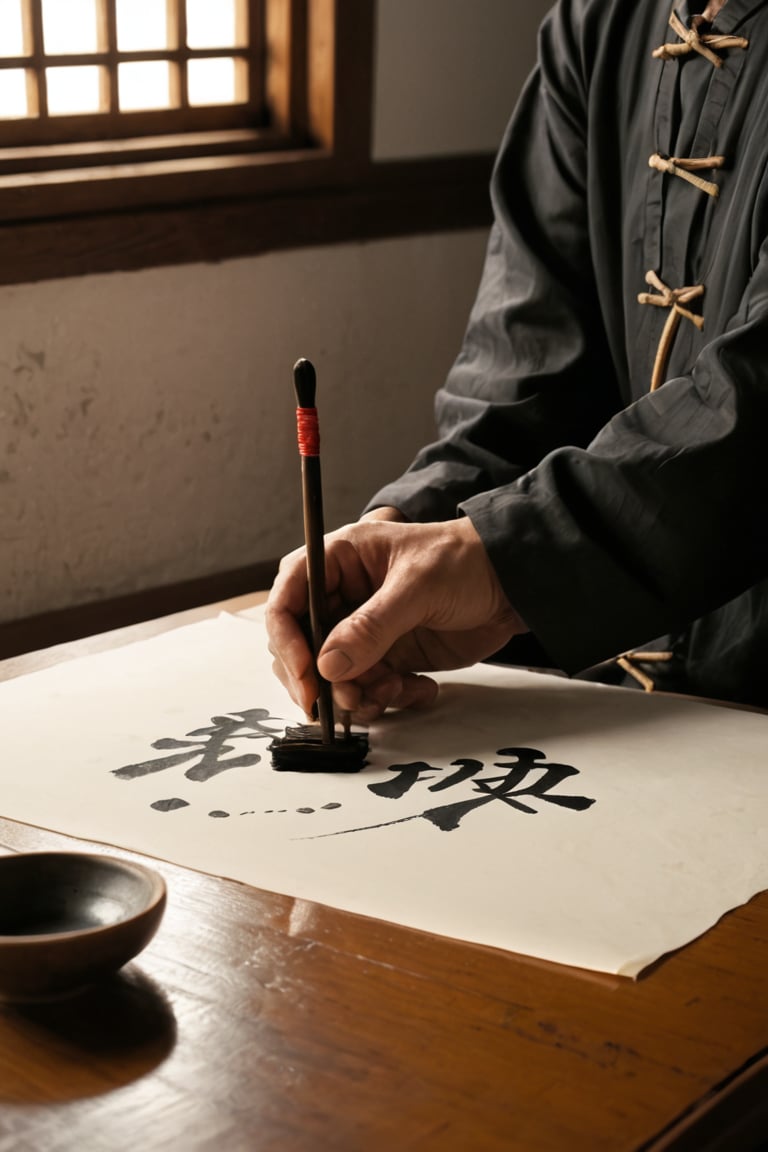Create a richly detailed and elegant illustration capturing the traditional process of Chinese calligraphy. The scene should progress from left to right, set in a serene, culturally rich environment, such as a scholar’s study or a quiet garden pavilion. Each stage should highlight the artistry, tools, and cultural depth of Chinese calligraphy:
1. **Preparing the Workspace:** Begin with a tranquil scene in a well-lit, serene study room or an outdoor pavilion surrounded by nature. Show a beautifully arranged calligraphy workspace with a smooth, clean surface. Include traditional elements like a low wooden desk, a silk scroll laid out, and a porcelain brush holder. The background should feature details like bamboo plants, ink paintings, or traditional Chinese decor.
2. **Selecting the Tools:** Illustrate the artist carefully selecting their calligraphy tools. Show a variety of high-quality brushes with different sizes and bristle types, ink sticks, and an ornate inkstone. Capture the texture and detail of the brushes’ handles, often made of bamboo or carved wood, and the fine craftsmanship of the inkstone.
3. **Grinding the Ink:** Visualize the process of preparing the ink. Show the artist grinding an ink stick against the smooth surface of the inkstone, with water added to create a rich, black ink. Highlight the rhythmic motion of grinding and the deep, glossy ink gradually pooling in the inkstone’s reservoir.
4. **Preparing the Paper:** Depict the artist carefully unrolling or unfolding the paper, smoothing it out on the desk. The paper, often delicate rice paper or silk, should be shown in a variety of forms, such as long scrolls or smaller sheets. Include details like paperweights or stones used to keep the paper in place.
5. **Brush Techniques and Practice:** Illustrate the artist practicing brush strokes on a practice sheet. Show the various techniques and strokes, from thin, delicate lines to bold, sweeping curves. Highlight the control and precision required to create each stroke, with the artist holding the brush vertically and moving it gracefully across the paper.
6. **Creating the Calligraphy:** Transition to the main scene where the artist is creating a piece of calligraphy. Show the brush moving fluidly, creating elegant Chinese characters or expressive brushwork. Capture the flow and rhythm of the brush, the varying pressure applied to create different line weights, and the ink absorbing into the paper. Include a close-up view of the brush tip and the texture of the strokes.
7. **Finalizing and Displaying:** Conclude with a scene of the finished calligraphy piece being admired or displayed. Show the completed scroll or artwork hung on a wall or being presented in a traditional frame. Include elements like a seal stamp being applied for the artist’s signature and red ink used for the stamp. Surround the scene with other artistic or scholarly objects, such as scrolls, books, or a peaceful garden view.
Use serene, natural tones and detailed textures to bring each stage to life, from the rich, black ink and delicate paper to the graceful brush strokes and the tranquil setting. Each stage should be clearly labeled to guide the viewer through the traditional process and artistic expression of Chinese calligraphy.
This prompt should vividly capture the meticulous and artistic process of Chinese calligraphy, highlighting the cultural depth and serene beauty of this traditional art form.



